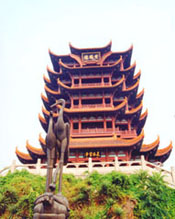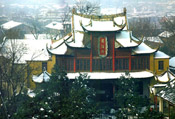|
Wuhan
Wuhan is located at the central part of China ,almost wholly located in the Jianghan Plain; sitting at the confluence of the world's third longest river, namely the Yangtze River and its longest branch Hansui River.
The name is a portmanteau label for the original triple settlements of Wuchang, Hankou and Hanyang, forever separate across the junction of the Han and Yangzi rivers, but given some sense of unity by three great interconnecting bridges.
Wuhan is a city with a long history and glorious revolutionary tradition, where the first shot of the Revolution of 1911 overthrew the rule of 2000 years feudalism in China; an important ancient town since the Shang and Zhou dynasties, the Spring and Autumn Period, as well as the Warring States; one of the famous important towns in China in the Song, Yuan, Ming and Qing dynasties; used to be the political, military and cultural center of the whole country for times.
Tourist Highlights |
| |
Yellow Crane Tower
Yellow Crane Tower, located on Snake Hill in Wuchang, is one of the "Three Famous Towers South of Yangtze River (the other two: Yueyang Tower in Hunan and Tengwang Tower in Jiangxi).
According to records, the tower was first built in 223 A.D during the Three Kingdoms period (220-280). After completion, the tower served as a gathering place for celebrities and poets to party and compose poetry. It was estimated that up to the Tongzhi Reign of the Qing dynasty, as many as 300 poems about the tower had been found in historical literature. Cui Hao, a famous poet during the Tang dynasty (618-907), made the tower well known throughout China with his poem "Yellow Crane Tower".
Destroyed many times in successive dynasties, the tower was rebuilt time and again until 100 years ago when it was, for the last time, reduced to ashes. The present tower is a complete reconstruction and is the result of four years of work beginning in 1981. |
 |
|
 |
Guiyuan Temple
Guiyuan Temple, situated on Cuiwei Street, is one of the four largest Buddhist meditation temples in Hubei as well as an important Buddhist temple in China.
The temple was first built in the early Qing dynasty (1644-1911) by two monks named Baiguang and Zhufeng on the base of Sunflower Garden which was owned by a poet. The temple got its name from the Buddhist chant: "When guided by purity, one can go anywhere."
The temple was destroyed and rebuilt several times in its history and the present temple dates from the early Republic of China (1912-1949). Covering an area of 46,900 square meters with a floor space of 20,000 square meters, the temple mainly consists of Daxiongbaodian Hall, Arhat Hall, and the Sutra Collection Pavilion |
|
|
| Other City |
|
 |
| Private China Tours |
|
 |
|

